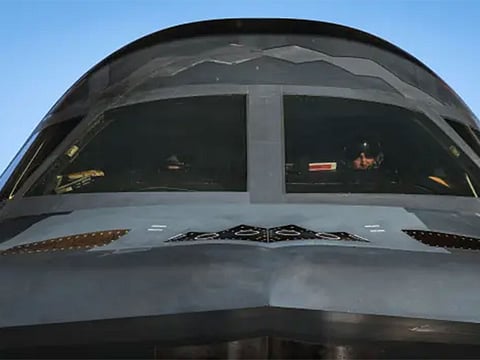Inside $2 billion B-2 bomber: How two pilots managed 37 hours of covert strike
Spirit stealth bomber has a chemical toilet, mini refrigerator and microwave

Dubai: Tucked within the angular, batwing design of the US Air Force’s B-2 Spirit stealth bomber lies a cramped but meticulously engineered cockpit — a space that becomes home for up to 40 hours during ultra-long-range missions like the recent 37-hour strike on Iran’s Fordow nuclear site.
Behind the clinical precision of the bombing raid lies a story of human endurance, discipline and deep psychological preparation.
The B-2 mission, code-named Operation Midnight Hammer, was the longest since the US assault on Afghanistan post-9/11.
Seven of the Air Force’s 19 B-2 bombers flew halfway across the world from Whiteman Air Force Base in Missouri to Iran and back, flying in near-complete radio silence, supported by a constellation of fighter jets and tankers for mid-air refueling.
At the heart of each jet: Two pilots trained not only in warfare but in sleep science, nutrition and psychological resilience.
A cockpit built for endurance
A chemical toilet, mini refrigerator and microwave are installed to ensure pilots can function over nearly two days in the air. A cooler packed with snacks rounds out the amenities.
Voices from the sky
Melvin G. Deaile is one of few people who understands what it is like to be in the cockpit during a marathon operation like the one carried out over the weekend.
The B-2, made by Northrop Grumman, is one of the most expensive and sophisticated bombers in use. But the toilet situation was primitive, according to CNN.
Chemical toilet
The chemical toilet is a compact, emergency-use toilet installed in the cockpit area. It’s extremely basic — no privacy, no running water, and usually only used when absolutely necessary to avoid overfilling or discomfort during long missions.
But high altitudes and pressurized cockpits can dehydrate pilots, and drinking water was crucial. Deaile estimated he and the other pilot drank about a bottle of water an hour.
Limited restroom access
Sleep in shifts, refuel in darkness
Managing sleep is critical. Pilots take turns flying and resting, relying on extensive pre-mission training in circadian rhythms and fatigue science. They even undergo sleep studies and receive personalized nutritional coaching. But even the best preparation is tested when, after 20 hours, you still need to refuel — blind.
B-2 refueling is done in the dark, relying solely on visual cues and memorised positions.
The refueling boom connects just 16 feet behind the cockpit — completely out of sight. On moonless nights, this already dangerous maneuver becomes even more nerve-wracking.
“Adrenaline keeps you going before you enter hostile airspace,” Basham said. “But afterward, the adrenaline fades. You’re exhausted. And there’s still that last refueling to survive.”
The Spirit number legacy
Every B-2 pilot belongs to a rare and elite community, each assigned a unique “Spirit Number” after their first solo flight. Only around 550 pilots have earned one since the first B-2 flight in 1989. The numbers aren’t reused, making them a symbolic badge of honor.
Former pilot Frank Cavuoti, Spirit Number 78, described it as “a numerical fingerprint that will only ever belong to you.” Even non-pilots who’ve flown in the B-2 — such as senior government officials and top enlisted airmen — receive a number, adding to the aircraft’s mystique and heritage.
For pilots, the Spirit Number signifies more than achievement. It represents a shared sense of responsibility and honor — what Cavuoti calls “the spirit, pride, tradition, heritage and esprit de corps” of being entrusted with America’s most advanced strategic bomber.
Machines and mortals
While the B-2’s aerodynamic shape, radar-absorbing coating, and advanced avionics make it nearly invisible to enemy defences, its success ultimately depends on its human crew. Pilots must coordinate with global assets, fly in silence through contested airspace, and drop bunker-busting bombs with flawless timing — all while battling physical exhaustion.
In Operation Midnight Hammer, 14 Massive Ordnance Penetrators (MOPs) were dropped on Fordow and another nuclear site.
Each B-2 flew a precision route, linked mid-flight with escort aircraft in “a complex, tightly timed manoeuvre,” according to Lt. Gen. Daniel Caine, chairman of the Joint Chiefs of Staff.
President Trump, in announcing the raid, said: “There is not another military in the world that could have done this.”
That capability doesn’t just lie in steel and stealth. It lies in two pilots, side by side in a cockpit the size of a walk-in closet, pushing the human body and mind to their limits, one mile and one hour at a time.
Sign up for the Daily Briefing
Get the latest news and updates straight to your inbox




